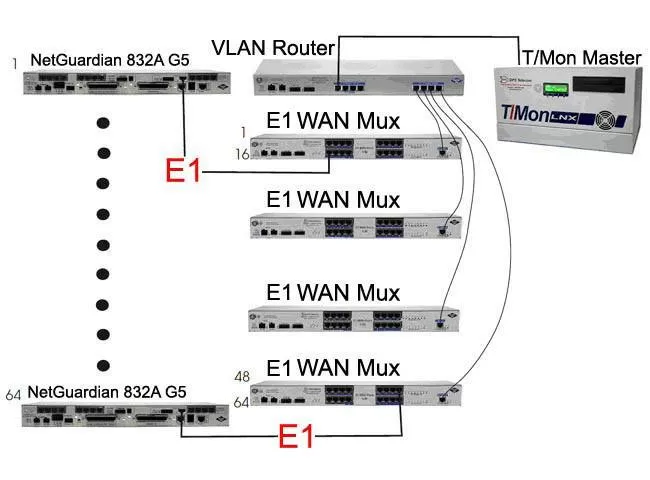Download our free Monitoring Fundamentals Tutorial.
An introduction to Monitoring Fundamentals strictly from the perspective of telecom network alarm management.
1-800-693-0351
Have a specific question? Ask our team of expert engineers and get a specific answer!
Sign up for the next DPS Factory Training!

Whether you're new to our equipment or you've used it for years, DPS factory training is the best way to get more from your monitoring.
Reserve Your Seat TodayThe National Grid Corporation of the Philippines (NGCP) was incorporated in 2008 when it assumed the crucial task of delivering safe and reliable electricity throughout the Philippines, a responsibility formerly held by the National Transmission Corporation or TransCo. The country's power transmission system involves 19,425 circuit kilometers of transmission lines and 23,853 MVA of substation capacity.
Ralph Manuel, Head of Planning System Operations for NGCP, describes the challenge of distributing electricity to so many islands. "To give you an idea, the country is composed of 7107 islands during low tide," he said. "During high tide, some are missing. We have some transmission cables between the big islands. Some islands have their own small 1.5 megawatt plants."
"We had to run multiple desktop programs to manage different gear from different vendors. Even different people were experts on each."
Since they provide transmission only, NGCP must also smoothly integrate with the many companies that own the country's generators in this era of privatization.
"We just transmit the power," said Manuel. "We're not the ones to decide which generator to choose to handle the load. That's why we have to make sure that communications are good. Everything used to be under one company, but plants were sold one-by-one during privatization."
Despite these challenges, customer expectations in the country are higher than ever before. "We are the only high-voltage transmission company in the Philippines," Manuel said. "We have just recently been privatized, and now we have just started market operations. We are under pressure to ensure that there are no outages, so we need telecom monitoring equipment. There's a higher expectation of service."

"We like the NetGuardian because we were looking for a management system to manage our facilities. We had some monitoring, but it was very limited."
After discovering DPS Telecom online, and as a result of subsequent inquiries, DPS Telecom arranged to send NGCP a demo NetGuardian RTU with a 125 VDC power supply. DPS used its custom design process to build and ship this new NetGuardian variant to NGCP for testing in their network.

"We like the NetGuardian because we were looking for a management system to manage our facilities," Manuel recalled.
"We didn't have sensors for environmentals, doors, and power supplies. We had some monitoring, but it was very limited. That's what led us to look for a facility management system. We had various management systems that were vendor-specific and proprietary. We had to run multiple desktop programs to manage different gear from different vendors. Even different people were experts on each. We needed to monitor these and other devices that are not part of the managed network using one monitoring system."
"IP cameras will be indoors for monitoring of the equipment room. We will use them to monitor for intruders. For normal operations, when we ask a technician to check or reset something, it will be simpler to guide them over the phone."
NGCP's new overarching monitoring system, composed of E1-capable NetGuardian RTUs, E1 WAN muxes, VLAN routers, and a T/Mon LNX master station, enable remote monitoring and diagnostics for equipment that was formerly managed with many disconnected systems. "For some particular types of equipment, like multiplexers, the T/Mon and the NetGuardians are for the fault management aspect," Manuel explained. "We do still need to use proprietary management interfaces for provisioning various pieces of equipment, but diagnostics can be done using the new fault management system."
NGCP will also use SiteMon IP surveillance cameras. "IP cameras will be indoors for monitoring of the equipment room. We will use them to monitor visual indications of trouble as well as for intruders," Manuel said.
"Also, some of our sites are manned, but only during normal business hours. There have been some issues, so we want to monitor these sites after hours. For normal operations, when we ask a technician to check or reset something, it will be simpler to guide them over the phone. You can see what they're doing. We had a demonstration of the cameras at DPS Headquarters, and we decided to get them."
"We have 3 big islands in the Philippines: Luzon, Visayas, and Mindanao," Manuel explained. "Luzon is a big island, the Visayas is composed of scattered islands, and Mindanao is another big island. These are our 3 main areas of operation. Even the power grid organization is broken into these 3 regions. The first rollout of the NetGuardians and T/Mon will be in Luzon since the national control center is in Luzon."
NGCP will evaluate their T/Mon, NetGuardian, and SiteMON IP camera system in Luzon before expanding into Visayas and Mindanao.
Similar Success Stories
Case Study: TBayTel Looks to NetGuardian, T/Mon to Secure Network
National Grid Protects Service Reliability with T/Mon, NetGuardians, and KDAs
National Grid Protects Service Reliability with T/Mon, NetGuardians, and KDAs
Northwest Communications Cooperative Purchases DPS Telecom Equipment
Nebraska Central Telephone Company Protects Upgraded Infrastructure with Advanced Alarm Monitoring
Nemont Telephone Gains Superior Network Visibility with T/Mon and "Rock-Solid" NetGuardians
RT Communications Success Story
RT Communications Prevents Service Disruptions Using T/Mon and NetGuardian RTUs
SAIC Protects Mission-Critical IT Services With Advanced Alarm Monitoring
Telikom Papua New Guinea grows by monitoring their network
Texas Lonestar Networks Builds Client Services on DPS Telecom Reliability
UnoTelos Brings Alarm Monitoring Foresight to Nigeria
NJ Transit Protects Rail Service with T/Mon and NetGuardian Remotes